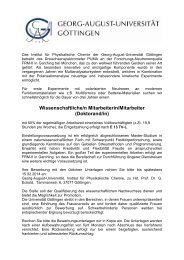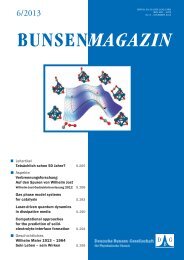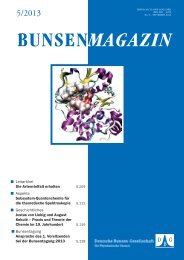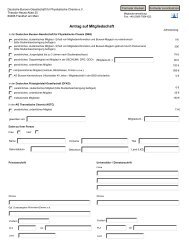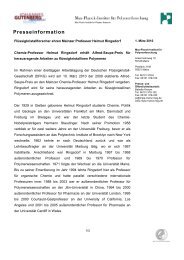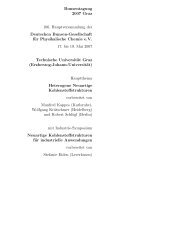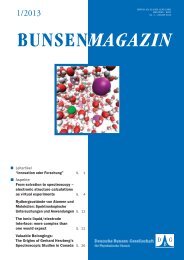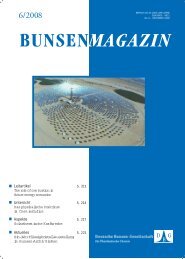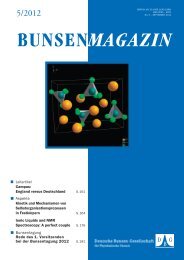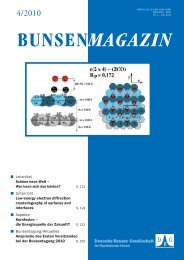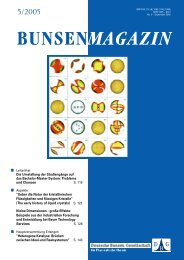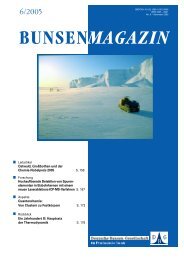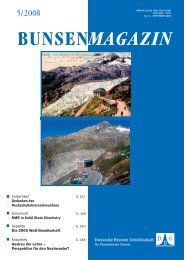bunsenmagazin - Deutsche Bunsengesellschaft für Physikalische ...
bunsenmagazin - Deutsche Bunsengesellschaft für Physikalische ...
bunsenmagazin - Deutsche Bunsengesellschaft für Physikalische ...
Erfolgreiche ePaper selbst erstellen
Machen Sie aus Ihren PDF Publikationen ein blätterbares Flipbook mit unserer einzigartigen Google optimierten e-Paper Software.
UNTERRICHT<br />
interaction responsible for level mixing 29,30 . Due to the strong<br />
anisotropy, the magnetic moment freezes along one of the two<br />
easy directions at low temperatures.<br />
FIG. 7: Principle of molecular<br />
magnetism as shown for the<br />
{Mn12012-(CH3COO)16(H2O)4]<br />
. 2CH3COOH . 4H20 spin cluster.<br />
In the absence of an externalfield,<br />
a set of double degenerate<br />
levels exists, the lowest<br />
with |mS |= S, if D < 0. Interconversion<br />
between degenerate<br />
bevels is termed “tunnelling“.<br />
FIG. 8: (Left) Frequency-domain zero field magnetic resonance spectra of<br />
Mn12-acetate as a function of temperature. At elevated temperatures additional<br />
resonances at lower frequency are detected, originating from |mS | = 9 and |mS | = 8<br />
levels. (Courtesy M. Dressel, Stuttgart.)<br />
FIG. 9: (Right) Time evolution of the transmission spectra at T = 1.96 K after the<br />
magnetic feld is reversed from +0.9 T to -0.9 T. The narrow absorption dip within the<br />
broad feature is due to resonant quantum tunnelling between pairs of coinciding<br />
energy levels. Also shown is the zero-field absorption line. From ref. 28 .<br />
The energy barrier ∆E ≅ 60 K between the two lowest-lying<br />
states mS = ±10 controls thermally activated relaxation of the<br />
magnetization. Below a blocking temperature of about 3 K, only<br />
resonant quantum tunnelling is possible, which was discovered<br />
in the form of steps in the hysteresis loops of the magnetization<br />
at regular intervals of the applied magnetic fi eld, corresponding<br />
to a coincidence of the zero-fi eld energy levels. This was confi rmed<br />
by direct spectroscopic evidence by observing the time dependence<br />
of the EMR signal after reversal of the external fi eld<br />
direction 28 . Reorientation of the local magnetization vector, i. e.,<br />
conversion from positive mS to negative mS or vice versa, is<br />
resonantly enhanced if degenerate levels are involved. Performing<br />
the experiment with a given BO, “absorption holes“ and<br />
“antiholes“ developed as function of time at expected fi eld positions,<br />
as shown in Fig. 9.<br />
106<br />
As mentioned in the introduction, the quantization of closed orbits<br />
of electronic motion can be used to determine the effective<br />
mass of carriers and, even more interestingly, to identify their<br />
dispersion relation. Periodic-orbit resonance in a quasi-onedimensional<br />
organic metal (TMTSF)2Cl04 (TMTSF standing for<br />
tetramethyl-tetraselenafulvalene) was observed when applying<br />
a magnetic fi eld transverse to the chain direction 6 . The effect<br />
was detected via the resonance in the mw conductivity. This<br />
resonance phenomenon is closely related to cyclotron resonance<br />
observed in metals with closed Fermi surfaces. Another<br />
beautiful example, although not invoking mw fi elds, is given by<br />
the observation of Landau Ievels in graphene, single sheets<br />
of graphite, for which the predicted linear dispersion relation<br />
of apparently massless fermions was detected by Scanning<br />
Tunnelling Spectroscopy (STS) 31 . In this experiment the quadratic<br />
dependence of the closed loop area of cyclic electron<br />
motion on the Landau quantum number was verifi ed, leading<br />
to a square root dependence of level spacings as function of<br />
quantizing fi eld. This was in contrast to the “normal“ dispersion<br />
relation, in which a quadratic dependence of the energy of “free“<br />
carriers on the momentum leads to a linear relationship instead.<br />
B. CHEMISTRY<br />
BUNSEN-MAGAZIN · 10. JAHRGANG · 3/2008<br />
lt would be far beyond the scope of this article to give a comprehensive<br />
review of EPR activities in chemistry. Here we want to restrict<br />
ourselves to topics, which could only recently be studied with the<br />
help of high frequency techniques. This narrows the examples<br />
down to high spin paramagnetic centers with large enough ZFS<br />
to either render them silent in standard 9 GHz EPR, or to prevent<br />
exploration of the full electronic spin multiplet. As examples we<br />
present recent results obtained from transition metal ions, being of<br />
importance in material science or coordination chemistry.<br />
As shown in Fig. 10, the full set of EPR parameters of octahedral<br />
Fe(II) in its high spin S = 2 state could be determined by invoking<br />
a special variant of high-frequency EPR 32 . In such an<br />
experiment, a series of EMR spectra is recorded, each with a<br />
fi xed mw frequency, which is subsequently varied quasi continuously<br />
from 150 to 700 GHz 10 . Without external magnetic<br />
fi eld, the fi ve-fold degenerate S = 2 state is split by ZFS into 3<br />
levels, one of it necessarily being a singlet state. According to<br />
the positive sign of the ZFS constant, this singlet level here is<br />
lowest in energy. Allowed EPR transitions can connect only to<br />
one of the upper ZFS Ievels, out of range for 9.4 GHz mw quanta.<br />
The data set displayed in the fi gure lists peaks observed in<br />
the spectra of the powder sample, corresponding to van Hove<br />
singularities, which are originating from canonical orientations<br />
of the molecule. These orientations are defi ned by the principal<br />
axes of the dominant terms in the spin Hamiltonian. The fi gure<br />
exemplifi es that full information about the spin system can only<br />
be obtained by recording absorption lines with variation of the<br />
mw frequency (being shown as vertical lines in the fi gure) over<br />
a wide range. The vast gain in information obtainable is obvious<br />
when expanding the frequency range beyond the commercially<br />
available range. Note that no signal would be observed with<br />
standard X-band EPR for this particular sample, and even when<br />
using the commercial 94 GHz spectrometer, only three signals<br />
within its fi eld range would be accessible. No elucidation of the<br />
spin Hamilton parameters would be possible. It should also be<br />
noted that not only full frequency coverage but also magnetic<br />
fi elds up to 17 T were necessary to perform the analysis. Admittedly,<br />
the example has been chosen deliberately to exemplify



